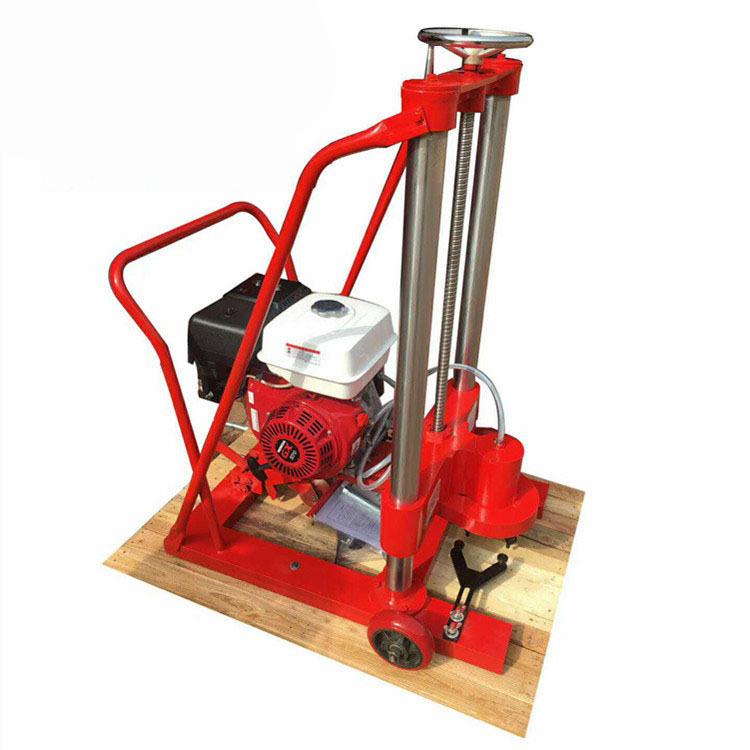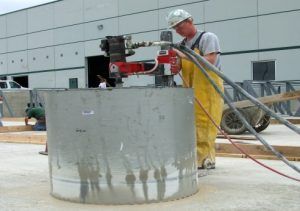A quick overview of the key components in Core Drilling Equipment
Core Drilling Equipment: Trick Realities and Insights on Its Function in Source Exploration
Core exploration tools is vital in resource exploration, allowing the extraction of round examples from the Planet's subsurface. This procedure allows rock hounds to evaluate natural resource and understand geological formations. Various approaches and technologies enhance effectiveness and safety and security in boring procedures. Nevertheless, the performance of core drilling can be influenced by several aspects. Understanding these aspects is vital for maximizing source monitoring and reducing ecological effects. What certain innovations and factors to consider form this significant field?
Introduction of Core Drilling Devices
Core exploration tools is important for acquiring round samples from the Planet's subsurface, promoting geological expedition and resource assessment. This specialized equipment commonly consists of a drill gear, core barrel, and numerous drill bits made for various geological problems. The drill rig offers the essential power and support, permitting deep penetration into the earth. The core barrel captures the drawn out material, guaranteeing marginal disruption to the example, which is crucial for precise analysis. Drill bits vary in design and product, often including diamond or tungsten carbide to improve durability and cutting effectiveness.
In addition, core exploration tools may include supporting parts such as water pumps for air conditioning and lubrication, in addition to sampling devices for accumulating and managing core samples. Together, these components allow geologists and designers to gather crucial data pertaining to natural resource, groundwater sources, and other subsurface features, eventually informing exploration and removal techniques.
Sorts Of Core Drilling Approaches
While different core exploration techniques exist to meet certain geological and job demands, each method supplies distinct advantages and applications. The most usual methods include ruby core exploration, which utilizes diamond-impregnated bits for efficient cutting via acid rock, making it suitable for mineral exploration. Alternatively, wireline coring enables for the quick retrieval of core examples, reducing disturbance and ensuring premium information collection. Reverse blood circulation drilling is favored for its speed and effectiveness in soft developments, as it brings cuttings to the surface area quickly. Furthermore, air core boring is commonly used for superficial, unconsolidated materials, giving an economical solution for initial assessments. Each technique has special functional requirements and is selected based on aspects such as deepness, rock kind, and task purposes. Understanding these varied techniques enables geologists and designers to select the most suitable method for their certain expedition demands.
Technical Developments in Core Boring
Recent technological improvements in core boring have substantially changed the sector, specifically via the introduction of automated core sampling strategies. These innovations enhance effectiveness and precision, enabling for more reputable information collection. In addition, enhanced drill little bit layouts have actually enhanced infiltration prices and longevity, more maximizing core boring operations.
Automated Core Testing Techniques
As developments in innovation remain to improve numerous markets, automated core sampling strategies have actually arised as a game-changer in core boring approaches. These developments streamline the sampling procedure by lessening human intervention and boosting accuracy in information collection. Automated systems use sophisticated robotics and sensing units to ensure accurate core removal and analysis, minimizing the risk of contamination and human error. In enhancement, real-time data purchase enables instant evaluation of core examples, promoting quicker decision-making in resource exploration. The assimilation of automation not just increases performance but additionally significantly improves safety and security by minimizing the need for employees in dangerous settings. In general, automated core tasting techniques are changing just how engineers and geologists approach subsurface analysis, leading to more educated exploration approaches.
Boosted Drill Little Bit Styles
Enhanced drill bit designs have considerably changed core exploration operations by integrating sophisticated materials and innovative geometries that maximize performance and sturdiness. Current advancements include using polycrystalline ruby compact (PDC) bits, which provide outstanding firmness and put on resistance, enabling deeper infiltration prices and prolonged life. Furthermore, boosted air conditioning and lubrication systems have been incorporated to reduce rubbing and heat generation, therefore boosting performance. Designs featuring specialized cutting frameworks permit better rock fragmentation and core healing, decreasing the risk of damage to valuable samples. The incorporation of sensing units and clever technologies further aids in real-time monitoring and performance assessment, making sure that exploration operations are not only effective yet additionally cost-efficient, noting a substantial advancement in core exploration techniques.
Applications of Core Exploration in Source Exploration
Core boring plays an essential duty in source exploration by facilitating mineral source analysis, which is crucial for recognizing and measuring important down payments. In addition, it improves geological research by giving important data that educates different clinical research studies. On top of that, core boring contributes in environmental effect researches, allowing for a better understanding of the potential results of resource extraction on ecosystems.
Mineral Source Evaluation
How can core exploration methods considerably contribute to mineral resource evaluation? Core exploration plays an important duty in accurately figuring out the top quality and quantity of mineral down payments. By drawing out round examples from various depths, rock hounds get a direct depiction of subsurface materials. This permits specific assessment of mineral framework, grade, and structure, which is crucial for informed decision-making in resource advancement. In addition, core exploration facilitates the identification of geological attributes and abnormalities, improving understanding of mineralization procedures. The information acquired with this technique is essential for resource estimation and plays a considerable duty in financial usefulness studies. Ultimately, see page core boring is an indispensable tool for advancing mineral source analyses in expedition tasks.
Geological Research Study Innovation
Progressing geological study, core exploration strategies offer crucial insights right into subsurface formations and mineral sources. By removing round examples from the Earth's crust, geologists can evaluate the physical, chemical, and mineralogical properties of various strata. This data is essential for understanding geological history, identifying potential source down payments, and evaluating the stability of removal procedures. Core samples expose information about rock kinds, structural geology, and fluid activity, which are crucial in establishing exact geological models. Furthermore, advancements in core drilling innovation, such as enhanced boring fluids and little bit styles, enhance the accuracy and effectiveness of example collection. In general, the assimilation of core boring into geological research greatly adds to educated decision-making in source exploration and management.
Ecological Impact Research Studies
While reviewing the ecological effect of resource exploration, core exploration functions as an essential tool for accumulating data that educates sustainable methods (Core Drilling Equipment). This technique allows researchers to get subsurface samples, allowing them to evaluate dirt and rock make-ups, groundwater high quality, and possible contamination. By evaluating these examples, environmental scientists can recognize the ecological repercussions of source extraction tasks. In addition, core drilling help in the advancement of reduction strategies to reduce damages to environments. The data gathered likewise sustains governing conformity, guaranteeing that exploration activities comply with ecological standards. Eventually, core boring not just enhances understanding of geological developments yet also promotes accountable source monitoring, stabilizing expedition needs with environmental management
Secret Variables Affecting Core Boring Efficiency
Core exploration performance is greatly influenced by several essential aspects that figure out the success of exploration procedures. One vital factor is the choice of exploration tools, which influences infiltration prices and core recuperation. The style and problem of drill bits play an essential function, as they should be fit to the geological conditions encountered. Additionally, the exploration strategy used, such as rotary or ruby drilling, can greatly influence performance.
One more important element is the experience of the drilling crew. Experienced operators can maximize boring specifications, decreasing downtime and enhancing efficiency. The geological attributes of the site, consisting of rock solidity and fracturing, likewise affect drilling speed and performance. Correct planning and task administration are essential in working with resources and minimizing hold-ups. Collectively, these variables contribute to the overall performance of core boring procedures, eventually affecting resource expedition outcomes.
Environmental Factors To Consider in Core Boring Procedures
Environmental factors to consider play an essential duty in core boring procedures, as they directly effect ecosystems and regional areas. These operations can disrupt environments, resulting in biodiversity loss and dirt disintegration. Using hefty machinery might produce greenhouse gases and noise air pollution, affecting both wildlife and human populations close by.
To mitigate these effects, operators have to follow strict ecological guidelines and take on lasting practices. This consists of using eco-friendly drilling fluids, handling waste effectively, and restoring sites post-drilling. In addition, engaging with local neighborhoods can promote openness and support, making sure that exploration tasks do not endanger public health and wellness or land use.

Frequently Asked Inquiries
What Safety And Security Steps Are Needed When Running Core Boring Equipment?

Just How Is Core Sample High Quality Assessed After Exploration?
Core sample top quality is evaluated via visual examination, measurement of physical homes, and research laboratory analysis. Aspects like recovery rate, core honesty, and Bonuses contamination degrees are assessed to ensure accurate representation of subsurface conditions.
What Are the Prices Related To Core Boring Projects?
Costs related to core exploration projects include equipment rental, labor, transportation, site preparation, and sampling. Furthermore, costs for ecological permits, site restoration, and analysis add to the total financial investment required for successful exploration procedures.
How Does Weather Affect Core Boring Workflow?
Climate substantially impacts core drilling operations. Rain, snow, or severe temperatures can impede development, affect devices efficiency, and produce security threats - Core Drilling Equipment. Proper planning and scheduling are necessary to alleviate weather-related interruptions in drilling tasks
What Qualifications Are Needed for Core Exploration Professionals?
Core boring professionals generally require qualifications such as the National Institute for Accreditation in Engineering Technologies (NICET) and OSHA safety training. Additional state-specific licenses might likewise be necessary to identify compliance with local laws and security standards.
